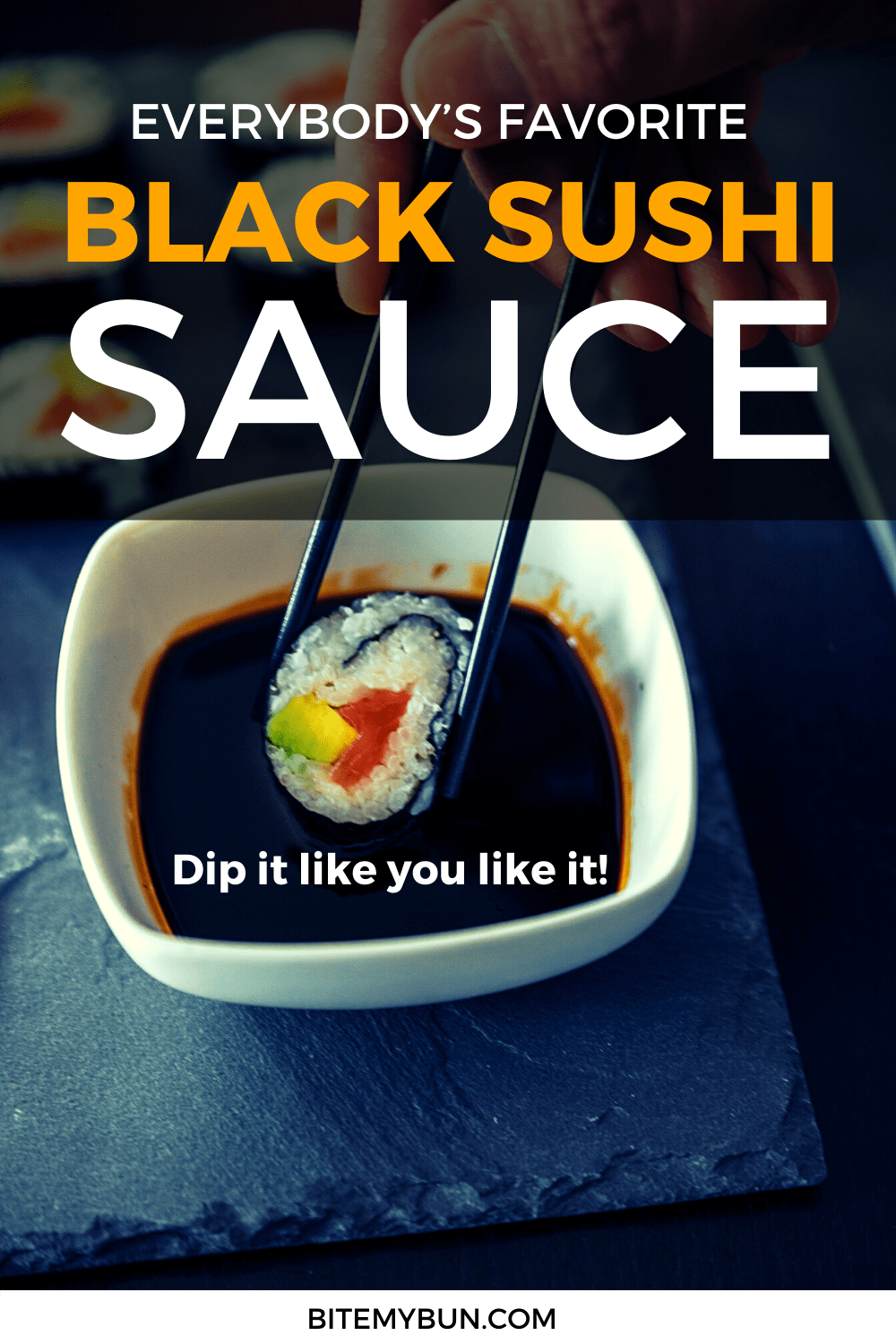16 Best Sushi Sauces: I Was Astounded When I Tasted #5!
If you’re a sushi lover, you know that the right sauce can significantly enhance your favorite dish’s flavors. But which one is best?
The truth is that there are so many different types of sauces to choose from, each with its unique flavors. As a result, it’s easy to get confused about what goes with what!
Our top 16 sushi sauce recommendations will help eliminate this confusion by offering you our suggestions for the most popular sauces. I’ve also included detailed information about each sauce AND when best to use it.
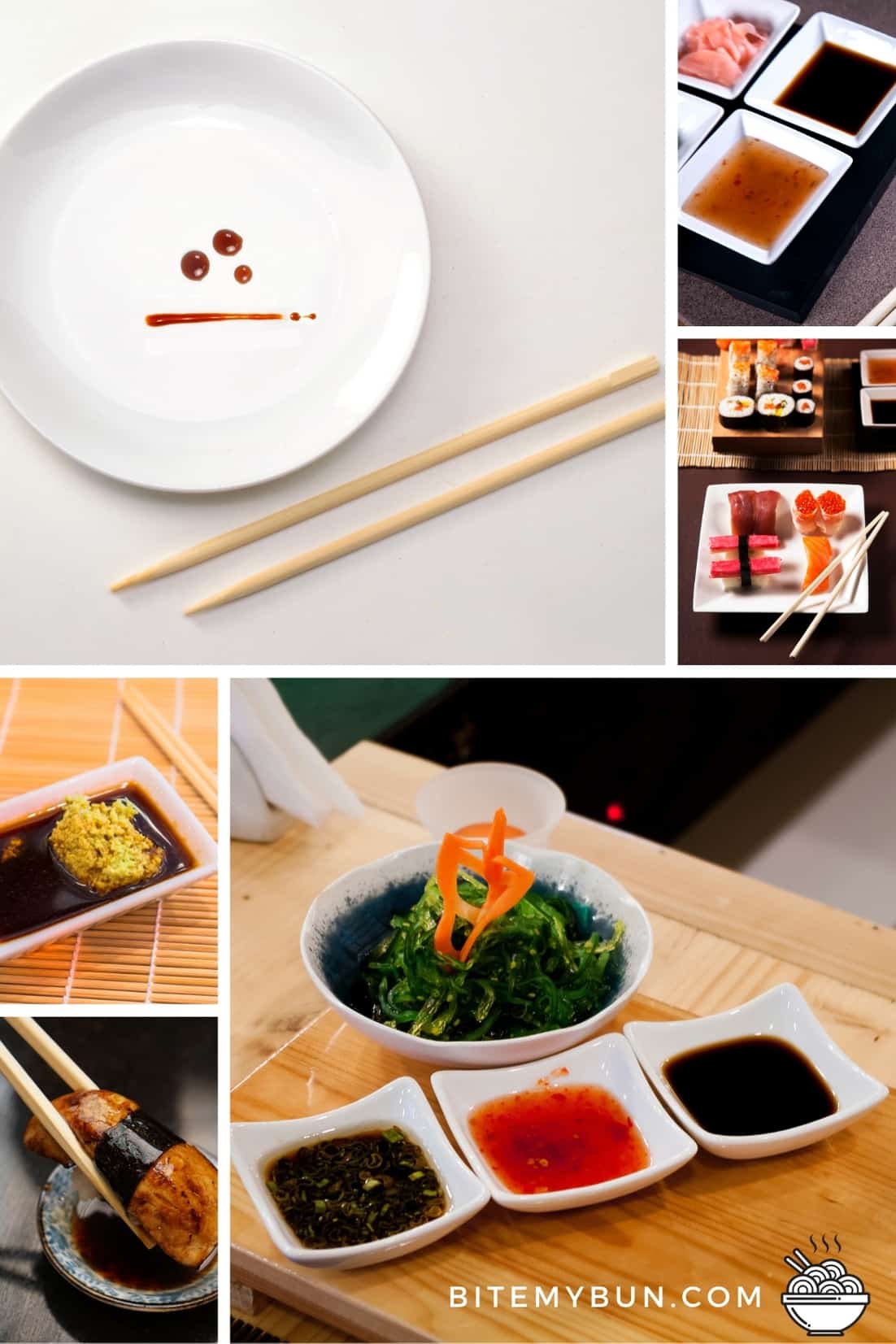
My favorite flavor to add to any sushi, but especially sushi with fish (it’s made for eel, you know!), is this Otafuku Eel sauce, which they often don’t deliver with sushi when ordering out. You don’t know what you’re missing!
But, of course, there are many more sauces and here are the most popular ones. Read on to find out everything you want to know about them:
| Sushi sauce names | Images |
|---|---|
| Brown sauce on top of sushi: Eel Sauce (Nitsume) | 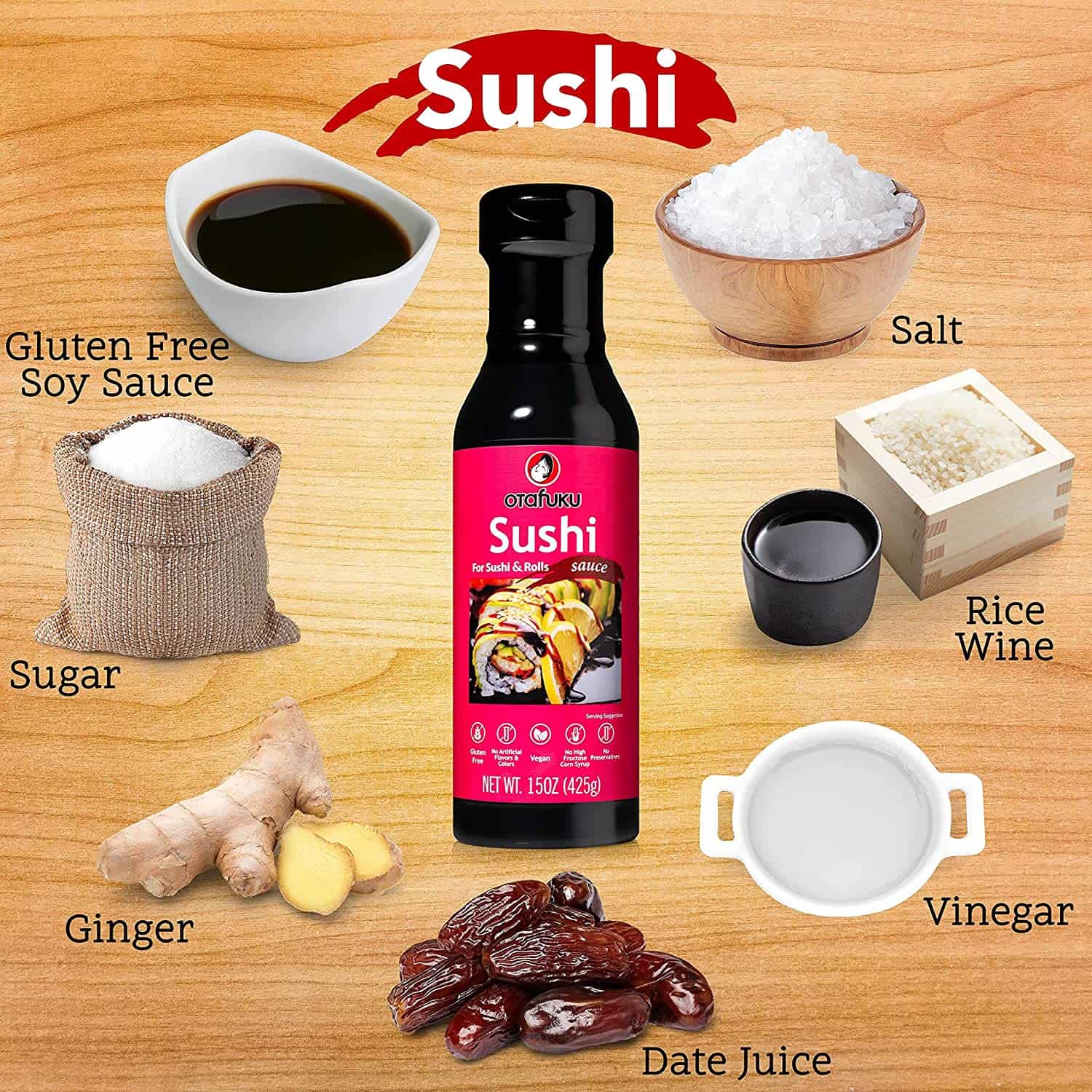 |
| Black sushi dipping sauce: Soy Sauce (Shoyu) | 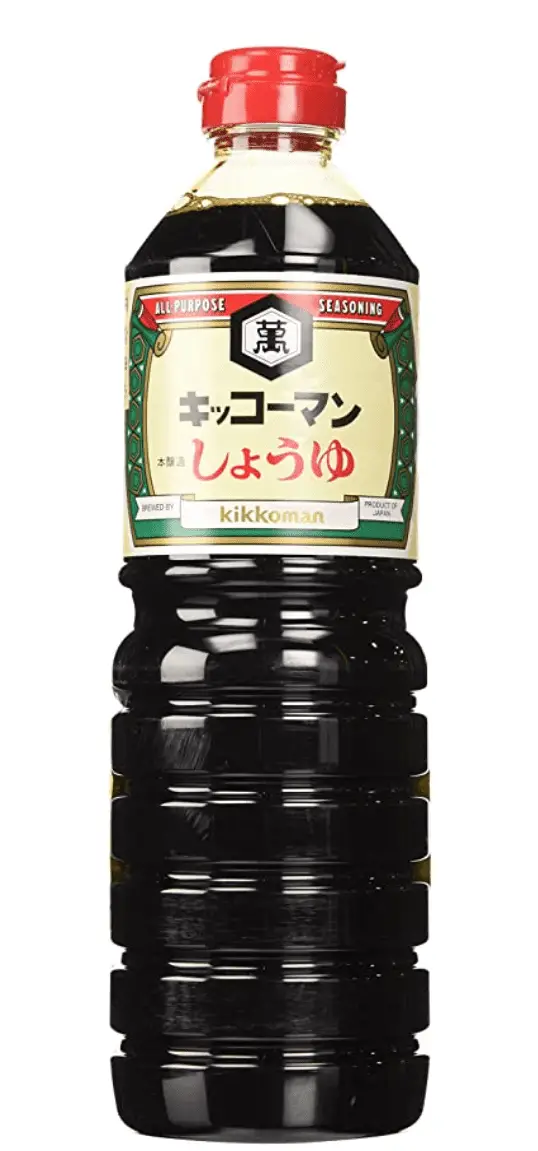 |
| Gluten-free soy sauce (served in most restaurants): Tamari | 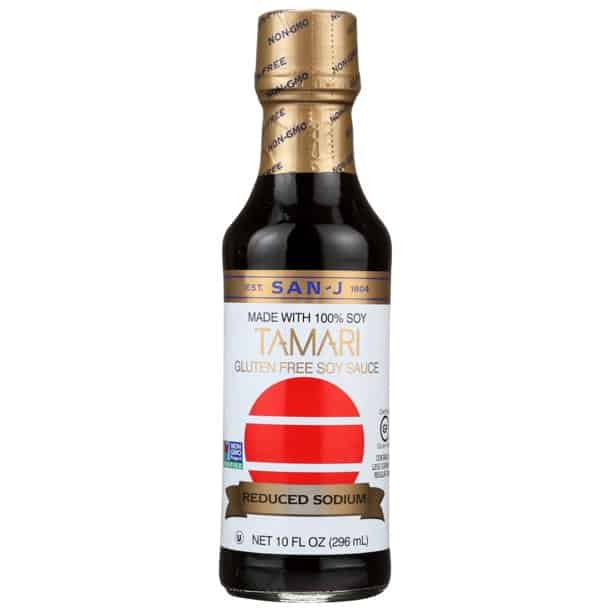 |
| Western sweet sticky glazing sauce: Teriyaki sauce | 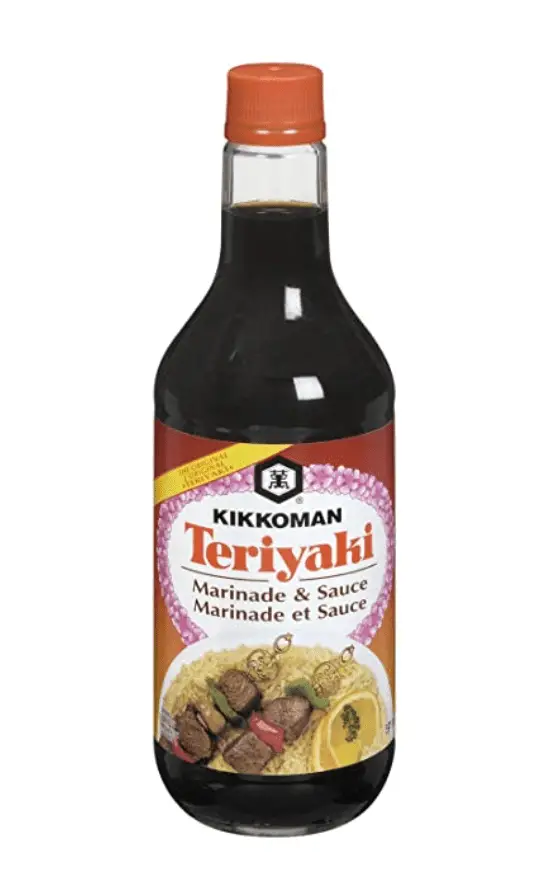 |
| Dark red sushi sauce: Tonkatsu Sauce | 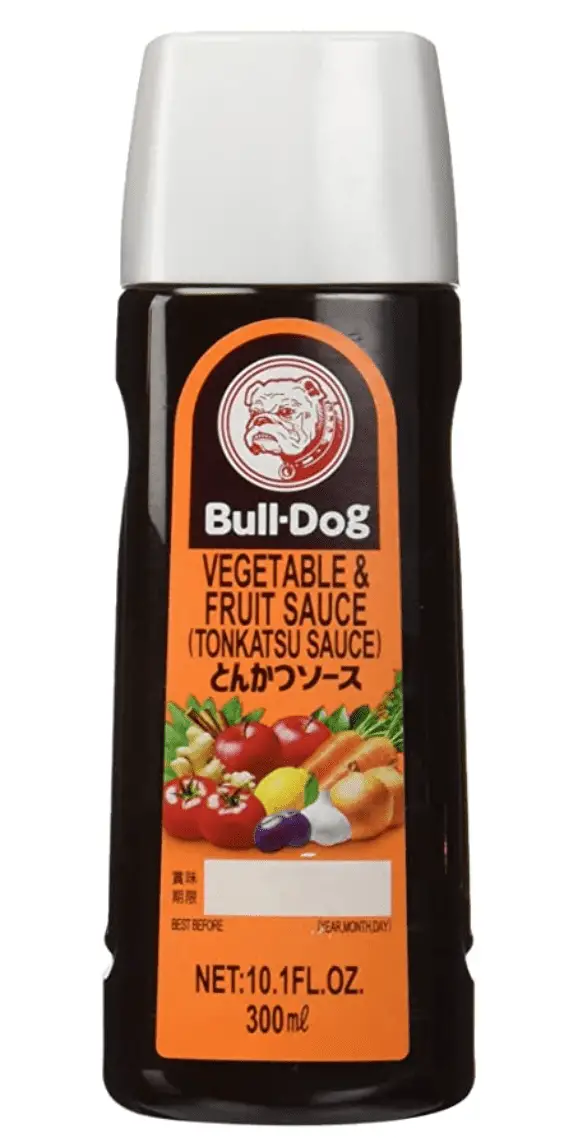 |
| Green sushi sauce: Wasabi Sauce | 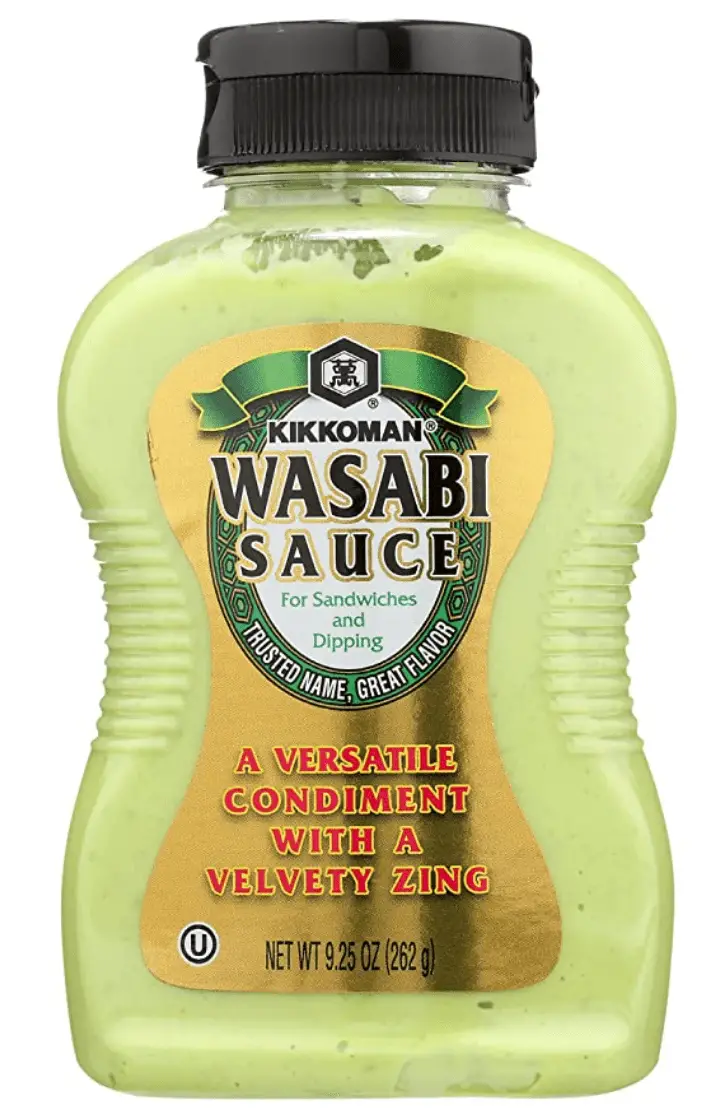 |
| Spicy red sushi sauce: Sriracha Mayonnaise | 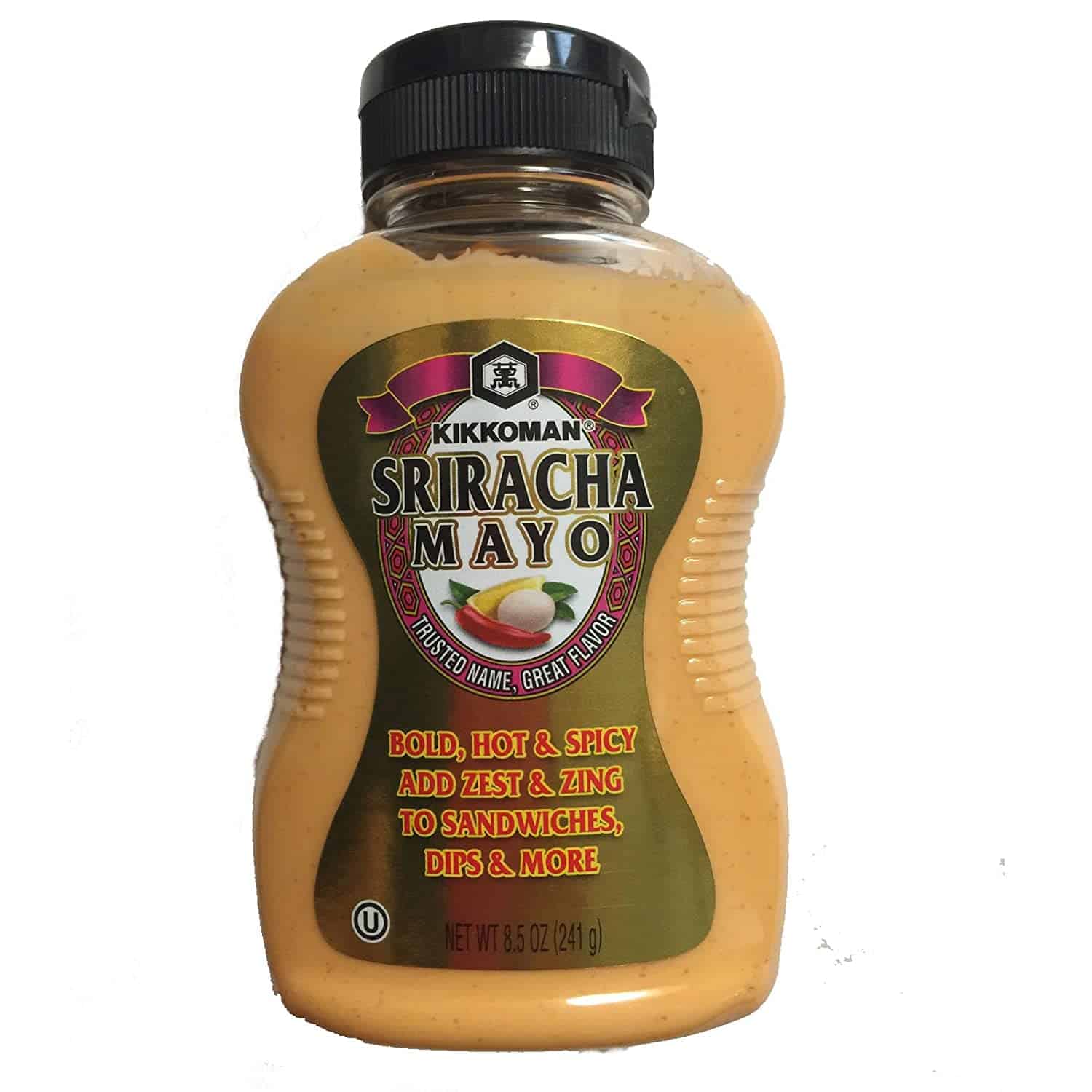 |
| Sushi mayo: Kewpie | 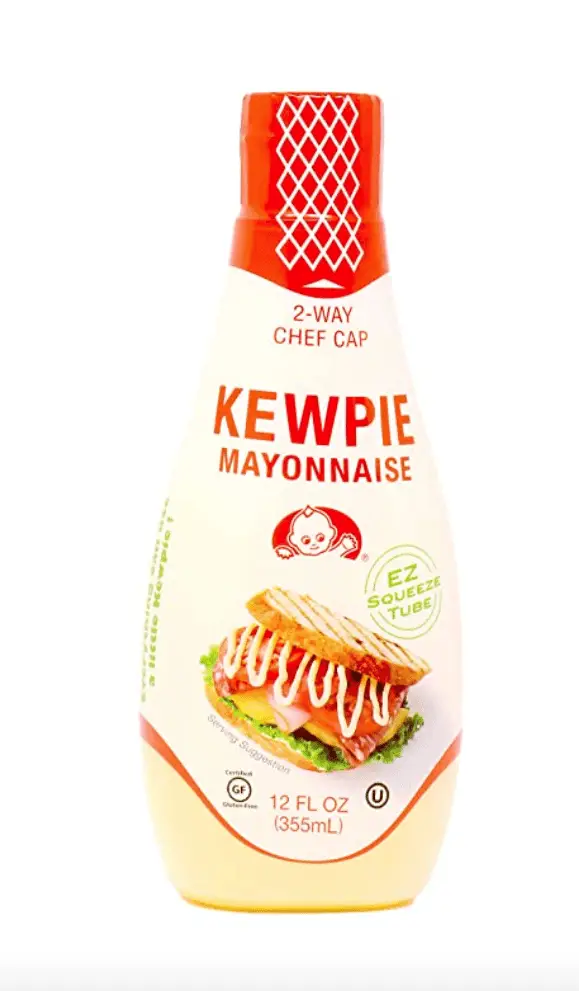 |
| Citrus-soy sauce: Ponzu sauce |  |
| Yellow sauce (Sakura white sauce): Yum Yum sauce | 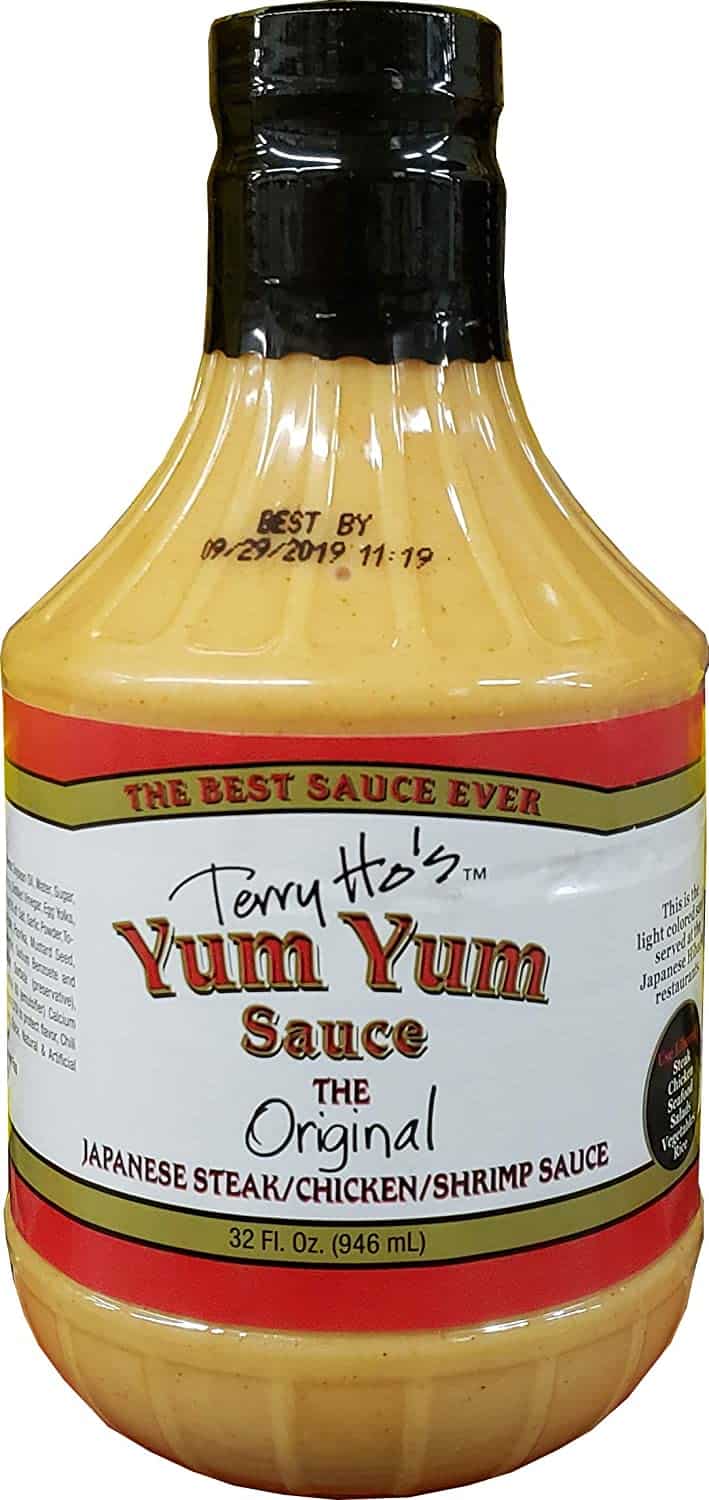 |
| Authentic sticky sweet sauce: Nikiri Sweet Soy Glaze | 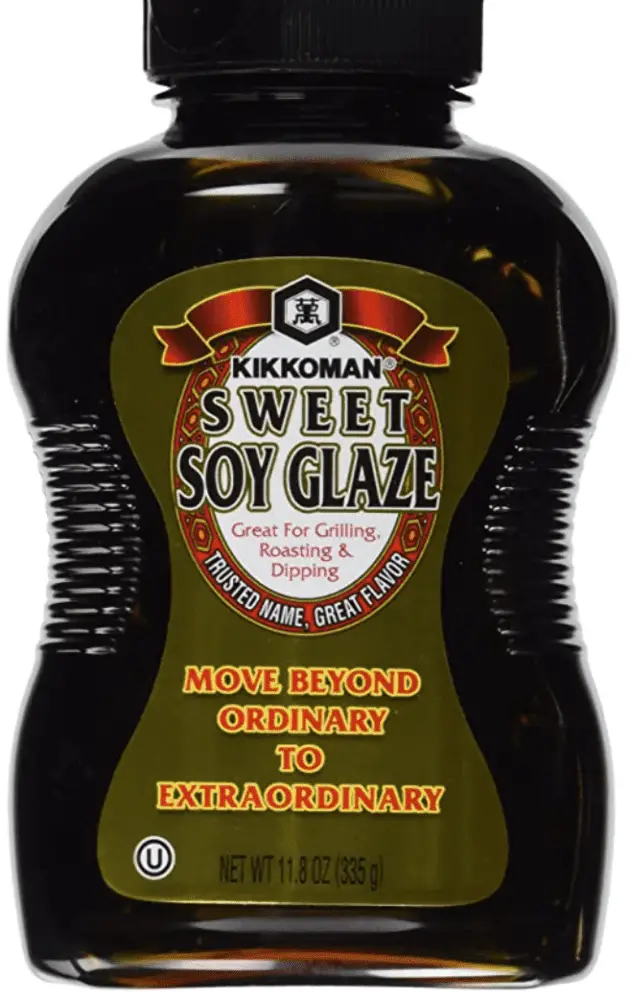 |
If you went back to pre-Meiji Era Japan, sushi would be dull and unimpressive to you because it didn’t come with the sushi sauces that people are accustomed to today.
The fact is that sushi sauces are a modern addition and are now common on most sushi rolls (luckily!).

Check out our new cookbook
Bitemybun's family recipes with complete meal planner and recipe guide.
Try it out for free with Kindle Unlimited:
Read for freeIn this post we'll cover:
- 1 Most popular sushi sauces
- 2 List of sushi sauce names
- 2.1 Brown sauce on top of sushi: Eel Sauce (Nitsume)
- 2.2 Black sushi dipping sauce: Soy Sauce (Shoyu)
- 2.3 Gluten-free soy sauce (served in most restaurants): Tamari
- 2.4 Western sweet sticky glazing sauce: Teriyaki sauce
- 2.5 Authentic sticky sweet sauce: Nikiri Sweet Soy Glaze
- 2.6 Dark red sushi sauce: Tonkatsu Sauce
- 2.7 Green sushi sauce: Wasabi Sauce
- 2.8 Spicy red sushi sauce: Sriracha Mayonnaise
- 2.9 Sushi mayo: Kewpie
- 2.10 Citrus-soy sauce: Ponzu sauce
- 2.11 Yellow sauce (Sakura white sauce): Yum Yum sauce
- 2.12 Sesame ginger dressing
- 2.13 Fish sauce
- 2.14 Vegan sushi sauce: liquid coconut aminos
- 2.15 Sweet & fruity mango sauce
- 2.16 Soy-free sushi sauce
- 3 Everybody’s favorite black sushi sauce
- 4
- 5 Sauce flavor combinations
- 6 The bottom line
Most popular sushi sauces
A large shift in sushi sauce popularity can even be seen in the last 5 years.
I’ve been looking at the search trends for the 4 most popular sauces and this clearly shows total popularity for sushi sauce searches has increased in the last 2 years.
The simple soy sauce was dethroned as the most searched in lew of more exotic sauces like spicy mayo.
Sushi sauce popularity per month over time
Eel sauce has also gained a lot in popularity over time, but the interesting thing to note is that there are also large differences in popularity by country.
Eel sauce and spicy mayo are the most popular searches in the States, while Canada has hardly any searches for eel sauce.
In Asia and Europe, soy sauce is still the most popular.
Relative sushi sauce popularity by country
However, using sauces on sushi isn’t just something of recent years.
It is widely known that sushi chefs have used a specially-made glaze for their nigiri even before the Meiji Era.
Now, they are very common, especially in Western sushi cuisine.
A large number of these sauces are quite versatile, and you can use them for different cuisines aside from sushi.
But if you’re in a hurry, let me share my favorite ready-made sushi sauces. After that, we’ll get into more delicious flavors and options.
List of sushi sauce names
Here is our list of the top 16 sushi sauces so you know exactly which sauce name is which and what filling to use them with.
Brown sauce on top of sushi: Eel Sauce (Nitsume)
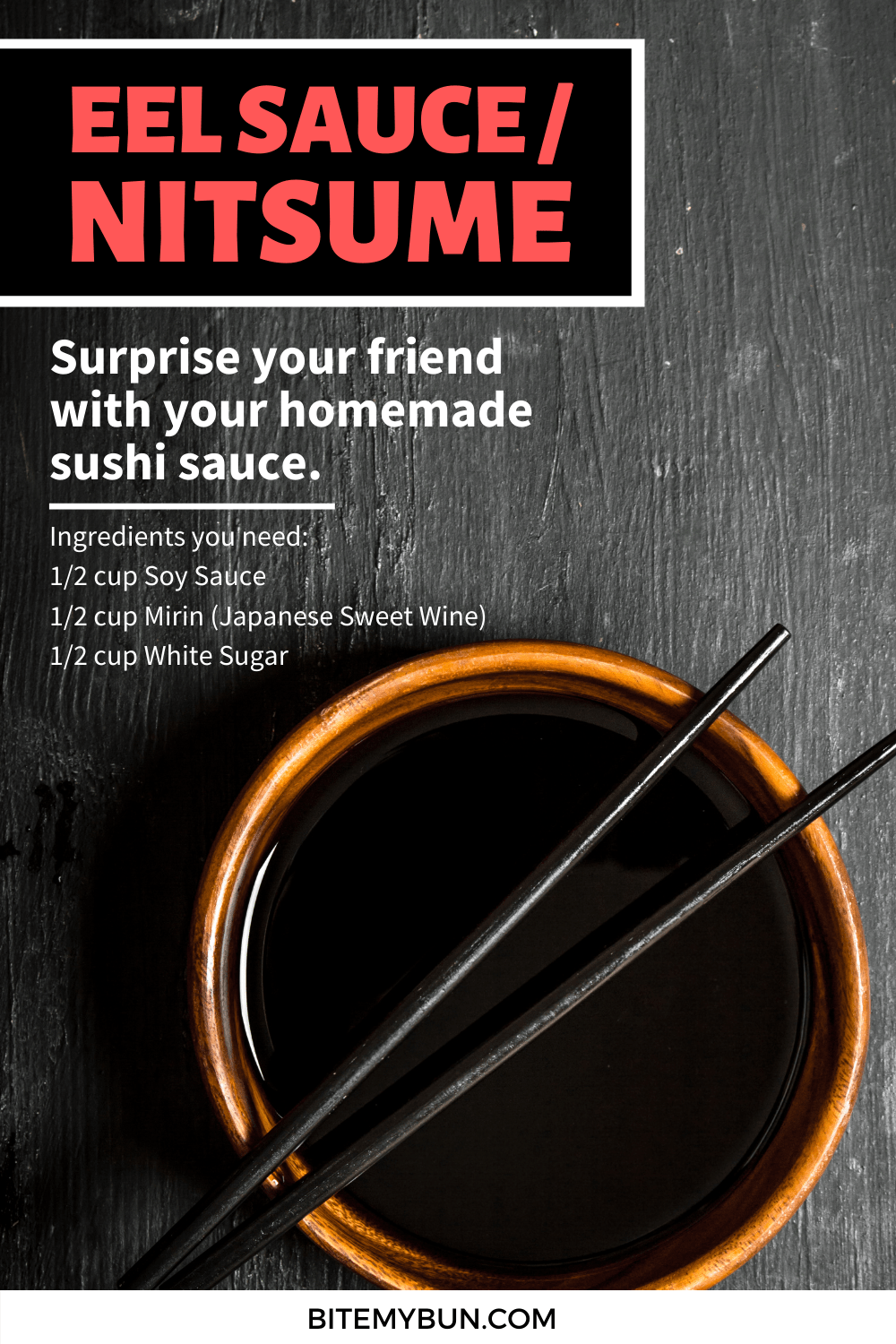
If your friends have been eating sushi for a while now and have fallen in love with the dark brown sushi sauce, then surprise them by telling them you’ve made a homemade version of it!
The Japanese call this sauce nitsume, and it is often used to drizzle on grilled eel and other fish toppings on sushi.
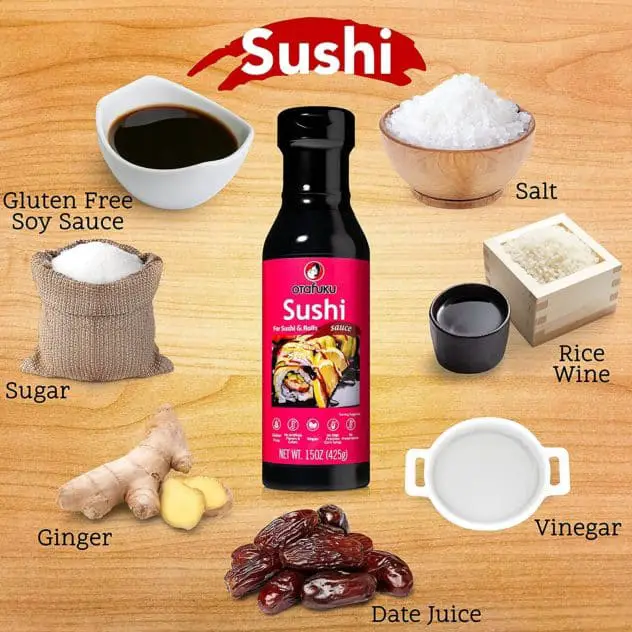
The Otafuku Sushi sauce is actually eel sauce, also known as unagi or nitsume.
It is:
- gluten-free
- vegan
- no MSG
- no high fructose corn syrup
- 1 tbsp = 40 calories
This sauce has a thicker consistency than soy sauce and has an umami flavor. I describe it as sweet, salty, and a bit tangy. It’s not quite like the unagi sauce you get in Japan at sushi restaurants but it’s a good option.
Eel sauce has a sweet and salty flavor that goes well with most sushi dishes.
Is eel sauce like oyster sauce?
Many people confuse eel sauce and oyster sauce. These two sauces share some similarities, but the texture of the eel sauce is lighter and thinner compared to thicker oyster sauce.
In some cases, it doesn’t contain any oyster at all, only an extract. Eel sauce is meant to be used as a topping on other eel dishes.
What does eel sauce taste like?
Eel sauce has a distinct and unique flavor. But, it’s most notable because it has a mixture of flavors combined into one sauce.
It has a traditional Japanese umami flavor, a sweet flavor, saltiness, and a hint of smokiness.
Since it tastes different from other sauces, the exact flavor is hard to describe. Some people even go as far as to say eel sauce is similar to BBQ sauce.
Black sushi dipping sauce: Soy Sauce (Shoyu)

Best soy sauce: Kikkoman Japan Made Soy Sauce
- 1 tbsp = 12 calories
- lower salt content than other brands
The taste of Kikkoman soy sauce is pretty well-known. It’s the classic salty and umami thin sauce you’re used to having with your sushi.
The vinegared sushi rice, tuna fish, and soy sauce are the primary ingredients crucial to making a perfect sushi dish with a subtle flavor and aroma.
Soy sauce is made by soaking soybeans in water and roasting and crushing the wheat, then salt is added to the mix and is processed until it is refined and gets that black color liquid.
The original soya sauce or shoyu gets its roots from ancient China. These days, we have 3 different types of soy sauce used for many dishes worldwide:
- The light soy sauce (the first type of soy sauce) has a reddish-brown color and is used for dressing, dips, and marinating ingredients.
- The dark soy sauce (the second type of soy sauce), on the other hand, has a caramel color to it with a thicker texture that can stain other ingredients and has a slightly sweeter taste.
- With a higher concentration of wheat, the thick soy sauce (the third type of soy sauce) has a thicker and almost viscous texture. It also has a sweet taste to it and chefs often use it as a dipping sauce.
Don’t waste soy sauce
This is a basic Japanese eating etiquette rule: do not waste any soy sauce as you eat sushi. Don’t leave behind a big puddle of sauce on the plate as this is frowned upon.
Pour a small amount of soy sauce into a sauce cup. Dip the rolls into the sauce and refill as required. It’s better to add too little sauce than too much.
If you want to go all out, use a chopstick to brush soy sauce onto the roll lightly. This ensures only a slight amount of soy sauce gets added.
If sushi is made well, it has enough condiments and flavors, thus you don’t need to exaggerate with sauces.
What is the best soy sauce for sushi?
Look for a high-quality soy sauce from a trusted brand.
Some soy sauces are more bitter than others. That’s why we suggest you try Kikkoman brand sauces.
This naturally brewed soy sauce has a balanced flavor. It is not too sweet and not too bitter. Therefore, it is the perfect flavor complement for rice.
It is the best choice for dipping sushi in because it doesn’t make the food mushy and sticky, like cheaper soy sauces.
Gluten-free soy sauce (served in most restaurants): Tamari
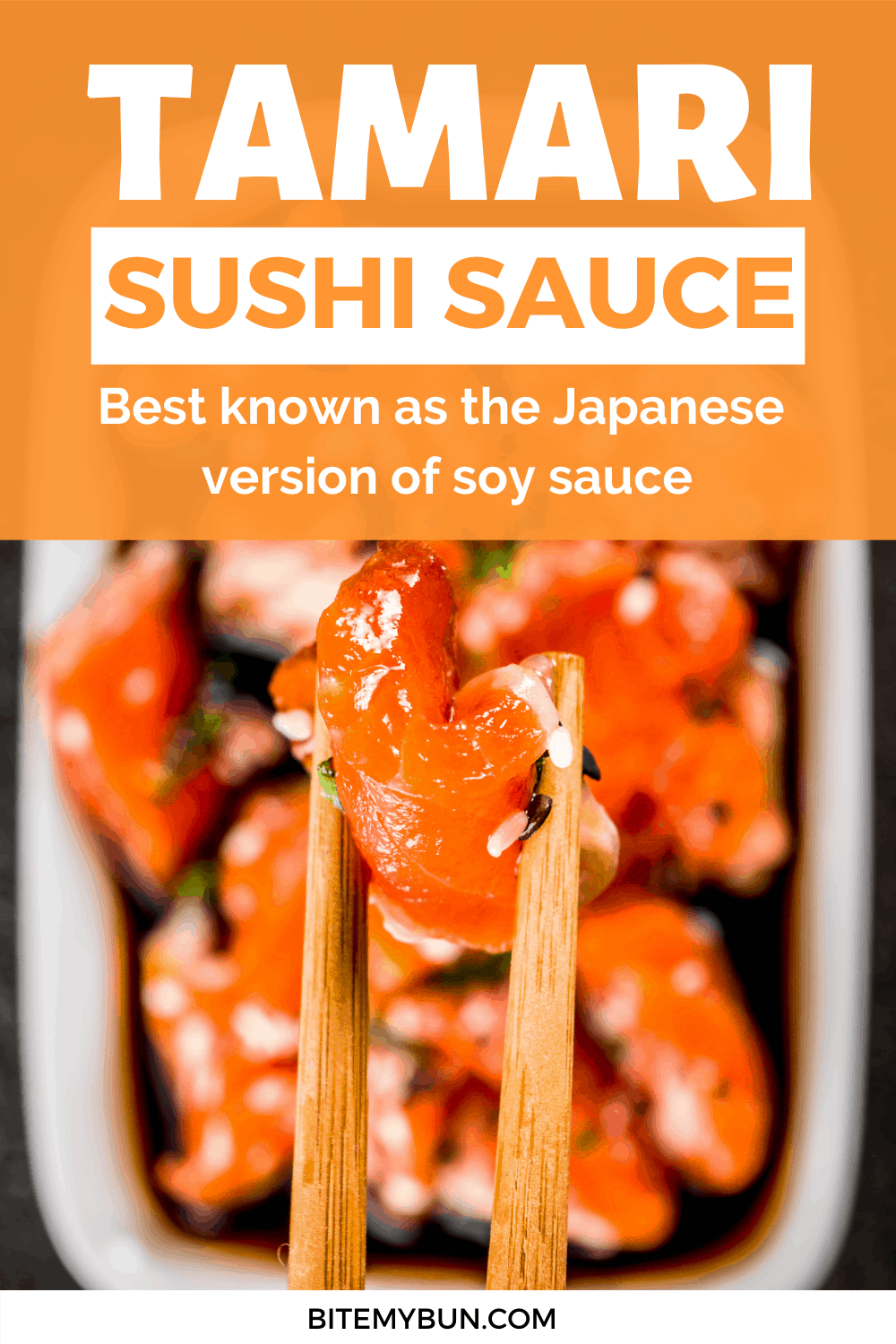
Best known as the Japanese version of soy sauce, but is vastly different from its Chinese analog.
Tamari sauce is fermented with less wheat which causes it to have a less salty flavor and thicker consistency.
Like dashi, tamari sauce is also used in various Japanese foods to add a savory umami flavor to them.
Tamari is the by-product of miso paste and is entirely different from the Chinese soybean. The latter is made by cooking soybeans with roasted wheat.
Almost no wheat is added to the product during the fermentation process, making it the perfect sushi sauce for gluten intolerant individuals.
What sauce comes with sushi rolls?
Most sushi restaurants will prefer to use tamari sauce over soy sauce. They typically mix it in when cooking their in-house recipes and serve it as a dipping sauce on the slices of sashimi fish and nigiri sushi (I explain the difference between the two here).
If you are on a celiac diet, then you can ask the chef to only serve you gluten-free tamari sauce and food on the menu.
You’re certainly not going to make a sauce like this yourself because of the extensive fermentation process involved. Still, I’ve found this San-J tamari sauce on Amazon to be excellent and very tasty!
- gluten-free
- Kosher
- vegan
- low sodium
- FODMAP friendly
- 1 tbsp = 10 calories

This Tamari sauce has that classic soy sauce flavor without gluten. It is the same thickness and combined with the vinegared rice and fishy sushi rolls, it adds a nice umami taste.
Also make sure to check if your sushi is actually gluten-free (here’s what you need to know)
Western sweet sticky glazing sauce: Teriyaki sauce
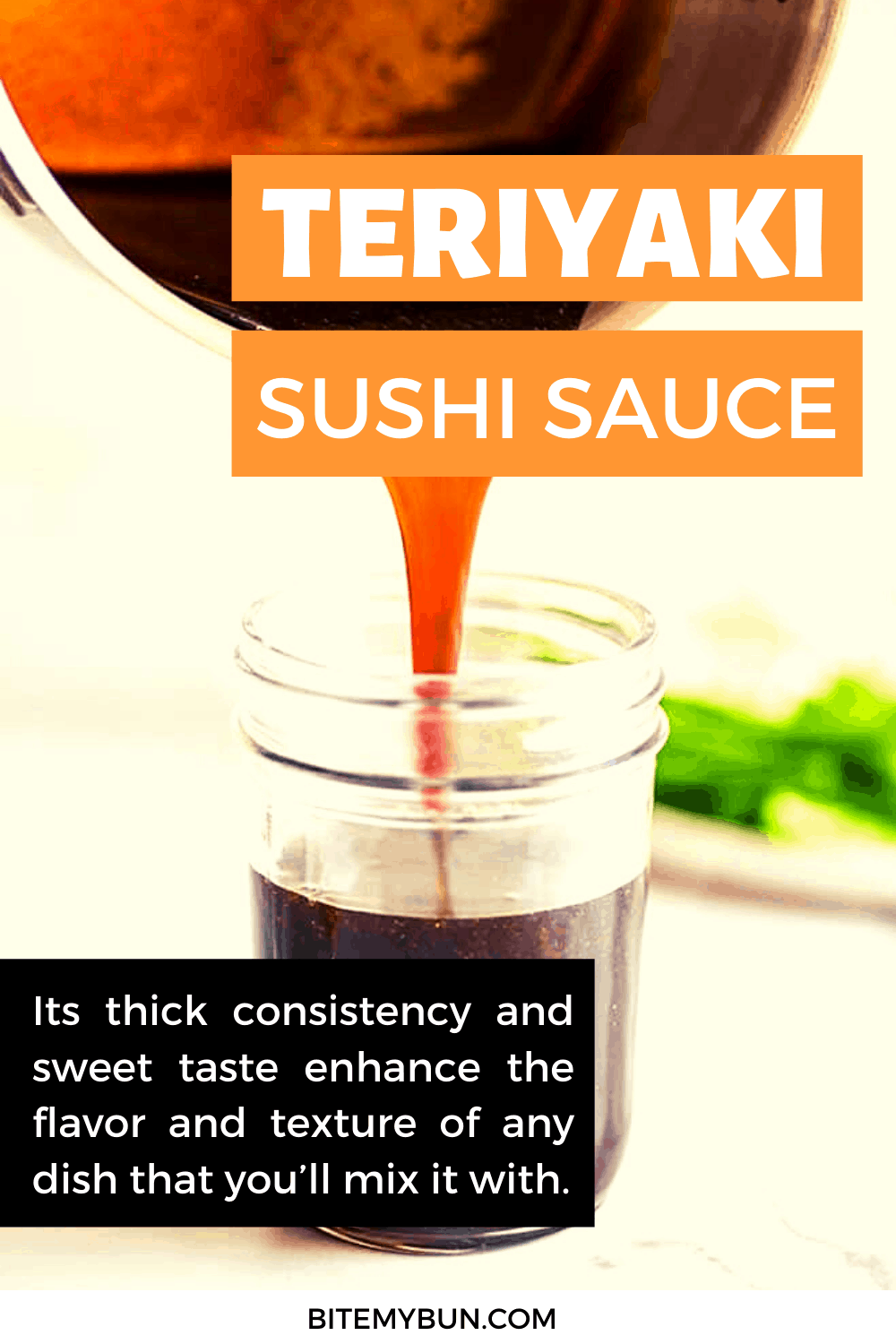
This is the black and sticky version of the soy sauce used to glaze fish on top of sushi.
Sometimes the sushi chef also uses it to drizzle over the California roll toppings to enhance its flavor. It possesses a strong flavor and thicker consistency, making it a good pair with a variety of dishes.
My favorite teriyaki sauce is Kikkoman’s Teriyaki sauce and glaze.
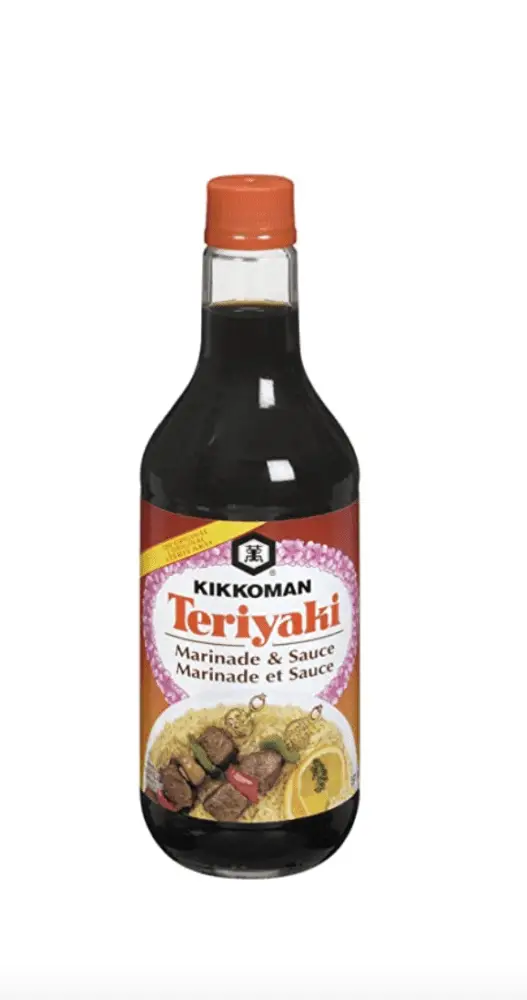
This teriyaki sauce is affordable and gives that classic sweet and fruity flavor you’re used to having in the States or Canada.
- Kosher
- 1 tbsp = 15 calories
Authentic sticky sweet sauce: Nikiri Sweet Soy Glaze
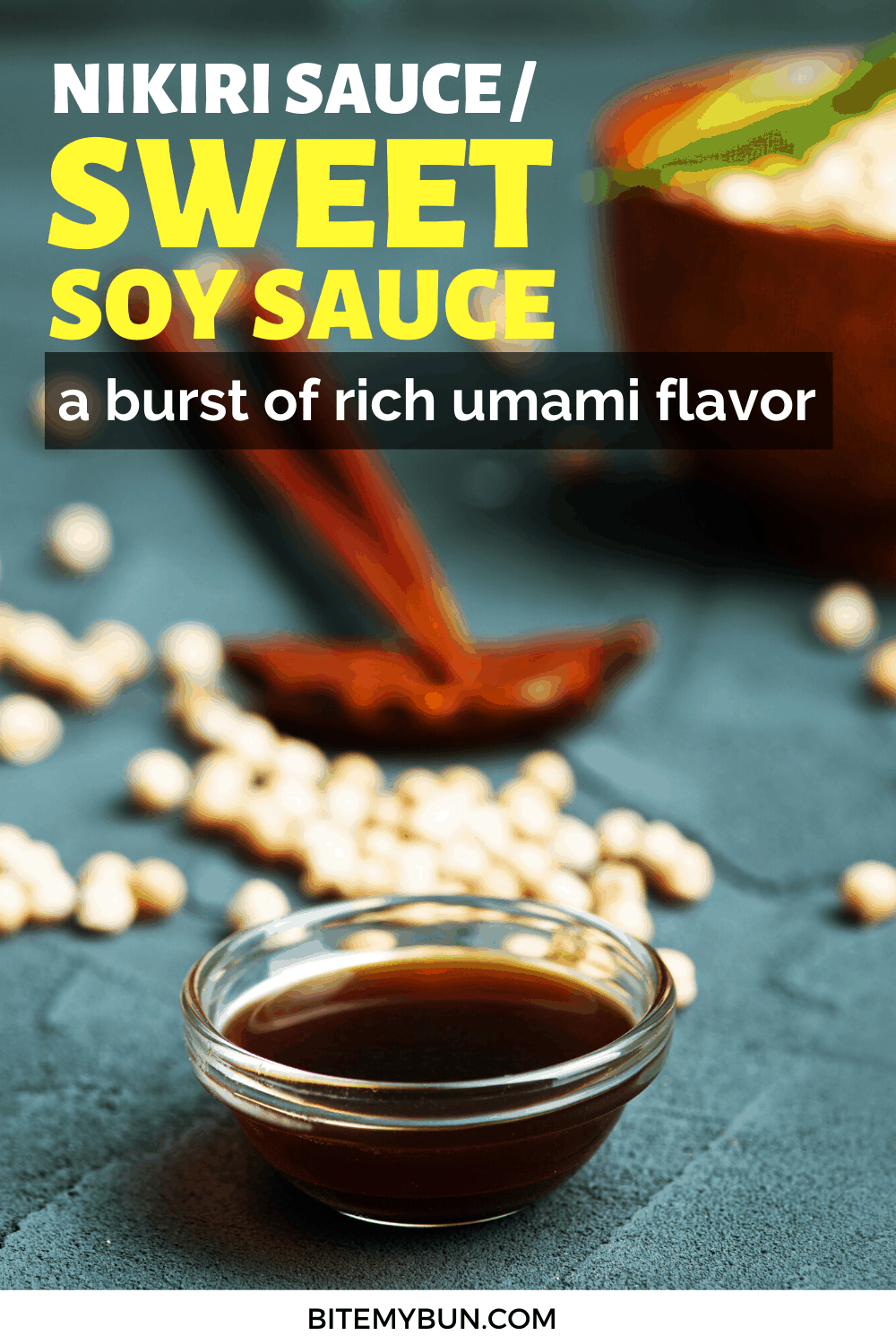
The nikiri soy-based sauce may not be everyone’s favorite sushi sauce, but it deserves mention. I was astounded when I tasted this for the first time.
My favorite is the sweet soy glaze sauce from Kikkoman.
It is almost exclusively used for nigiri toppings and although made from soybeans, this sushi sauce has a rather light brown color and sweet taste.

And while the other sushi sauces have a thicker consistency, this one though has a thinner texture but offers a burst of rich umami flavor that is not found in any other sushi sauce.
This sweet soy glaze sauce is also great to serve with yakitori chicken skewers!
Dark red sushi sauce: Tonkatsu Sauce
Much like the two previous sauces, Tonkatsu sauce is a tastier and thicker version of soy sauce. In Japan, they serve Tonkatsu as a marinade drizzled over the fish toppings on your nigiri or uramaki rolls.
Although tonkatsu sauce is served over crispy pork cutlets, it has a yummy flavor that works for sushi rolls too.
My favorite is the Bull Dog Tonkatsu sauce which has a sour and savory flavor, similar to the vinegared rice.

Its thick consistency and sweet taste enhance the flavor and texture of any dish you mix it with.
- 1 tbsp = 25 calories
Learn more about Japanese cuisine and all it’s amazing flavors here
Green sushi sauce: Wasabi Sauce
Yes, you read that right – wasabi sauce, not paste.
Wasabi paste is one of the most popular sushi toppings. But, did you know you can make your own spicy wasabi sauce at home?
It’s an easy way to add extra flavor and spiciness to any sushi roll. You’ll love Wasabi sauce if you want to add some kick to your food.
Authentic wasabi is quite expensive, so sushi fast food restaurants offer a substitute with a similar taste.
Wasabi is Japanese horseradish and it is more pungent than Western horseradish varieties. The paste is made with Kudzu. People say it tastes like a mixture of horseradish and mustard. You can recognize Wasabi paste by its green color and powerful scent.
Many people prefer the sauce because it has a semi-thick texture so you can dip the sushi rolls in it. It’s easier than eating the wasabi paste and the taste is very similar.
If you want to try a delicious wasabi sauce is go for Kikkoman Wasabi Sauce.
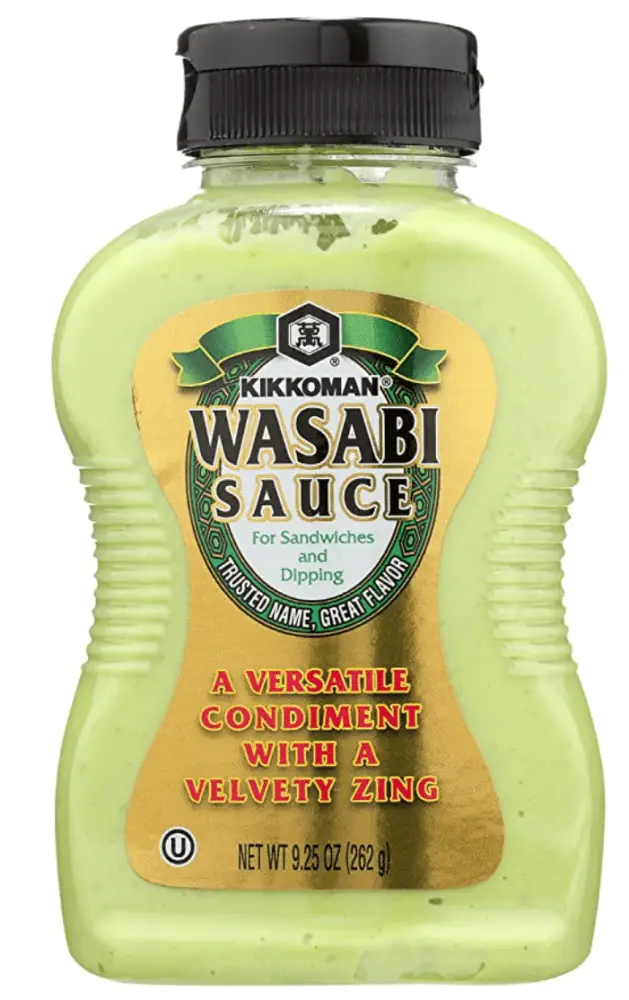
- 1 tbsp = 10 calories
The sauce is also created from Japanese horseradish and has that same bright green color and a hot flavor. It has a bit of a pungent flavor but it’s spicy and can still make you feel all the spiciness.
If you like something hot for your sushi, you’ll love this type of sauce.
Spicy red sushi sauce: Sriracha Mayonnaise
What is the red sauce on sushi?
A lot of restaurants in America will serve a red spicy mayo sauce on some of their sushi rolls as it adds a nice kick to the dish.
It’s made from may and chili sauce and commonly used on dragon rolls for example, but it’s not a traditional Japanese sushi sauce.
Basically, this is a spicy mayo with sriracha sauce.
One of the bestsellers is Kikkoman Sriracha Mayo because it works well on all sushi, not just dragon rolls, and adds a spicy kick for hot sauce lovers.

This sauce has a bold spicy flavor with a bit of zest and zing to it. You can also use it to dip fries or fried Japanese foods or instead of regular mayo in sandwiches.
Just a heads up, this sushi sauce is high in calories.
- 1 tbsp = 80 calories
Sushi mayo: Kewpie
There’s a big difference in flavor between regular Hellman’s mayo or other Western bottled mayos.
The flavor of Kewpie mayo is less sweet than its American counterparts. Also, the taste is best described as “umami” with a sweet and fruity flavor. The taste of eggs is very prominent.
In terms of color, it has a light yellow hue, and it’s thicker. You can squeeze the mayo from the bottle and drizzle it on the sushi rolls. It adds a lot of richness and depth, especially to lighter flavored rolls.
The best Japanese mayo is no doubt the original Kewpie brand mayo.

- 1 tbsp = 110 calories
This mayo sauce is high in calories, so consume it in moderation.
Kewpie mayo is used as a topping for sushi or inside the rolls. One of the best ways to incorporate mayo inside the sushi rolls is to make tuna and avocado rolls.
Once you’ve placed the vinegared rice on the Nori rolls and added the tuna and avocado slices, drizzle kewpie mayo. It adds a sweet and umami flavor.
Citrus-soy sauce: Ponzu sauce
This tangy flavored soy-based sauce has quite a similar function as the other sushi sauces in this article, and it is used as both a dipping sauce and a marinade for seafood to enhance their flavor.
Although it could not be verified historically, it is believed that ponzu sauce got its tangy flavor from adding fresh citrus (lemon or orange) juice, which Holland traders inspired in the 17th century.
The Kikkoman Ponzu sauce is one of the best. It has a strong citrus and soy flavor.

- 1 tbsp = 10 calories
A traditional ponzu sauce is a thin watery sauce with citrus flavors.
Here are the ingredients to prepare Ponzu Sauce at home (full recipe here).
Why do you eat ponzu sauce with sushi?
Ponzu has a delightful citrus flavor, and citrus is a classic complementing flavor for seafood. Since most sushi rolls contain seafood, Ponzu sauce is an excellent topping or dipping sauce.
It is ideal for sashimi, as the lemony notes give salmon a potent flavor. The taste of Ponzu sauce covers the flavor spectrum. Thus, it’s a good match for sushi rolls.
Yellow sauce (Sakura white sauce): Yum Yum sauce
If you haven’t heard of Terry Ho’s special yum yum sauce, you’re seriously missing out.
This sauce is marketed as a Hibachi sauce for Japanese BBQ or for chicken and shrimp dishes. However, there’s nothing stopping you from dipping sushi roll into it.
The taste is best described as a mix between ranch dressing and mayo with a pleasant sweet mild flavor.
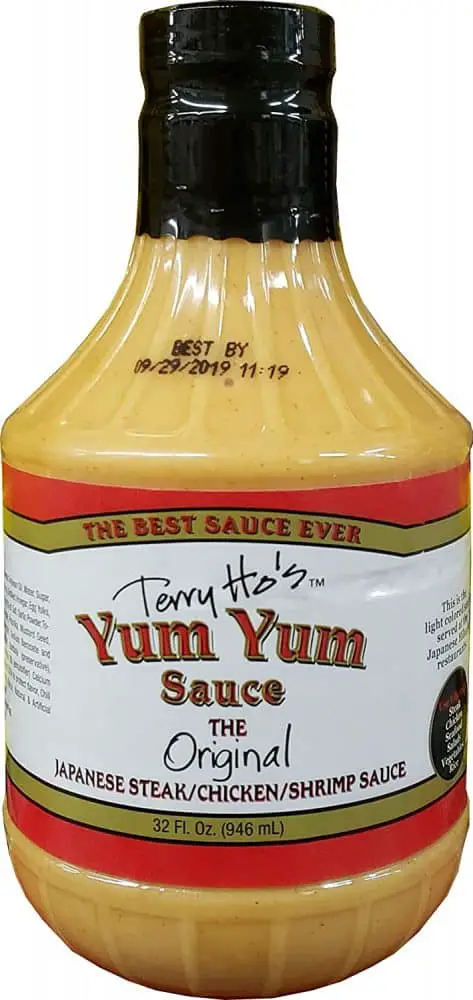
- 1 tbsp = 85 calories
Yum Yum Sauce is a great sauce for dragon rolls and California rolls, as well as a great substitute for spicy sriracha mayo if you don’t like spicy sauces.
Sesame ginger dressing
There’s Kewpie mayo, and then there’s sesame ginger dressing. It’s mostly used as a salad dressing for all kinds of Japanese salads but there’s no reason not to drizzle it over sushi.
It has a rich, savory, nutty flavor with a hint of that peppery ginger taste. The texture is a bit viscous, similar to sriracha mayo or regular Kewpie mayo.
You can easily find it on Amazon: Kewpie Deep Roasted Sesame Dressing
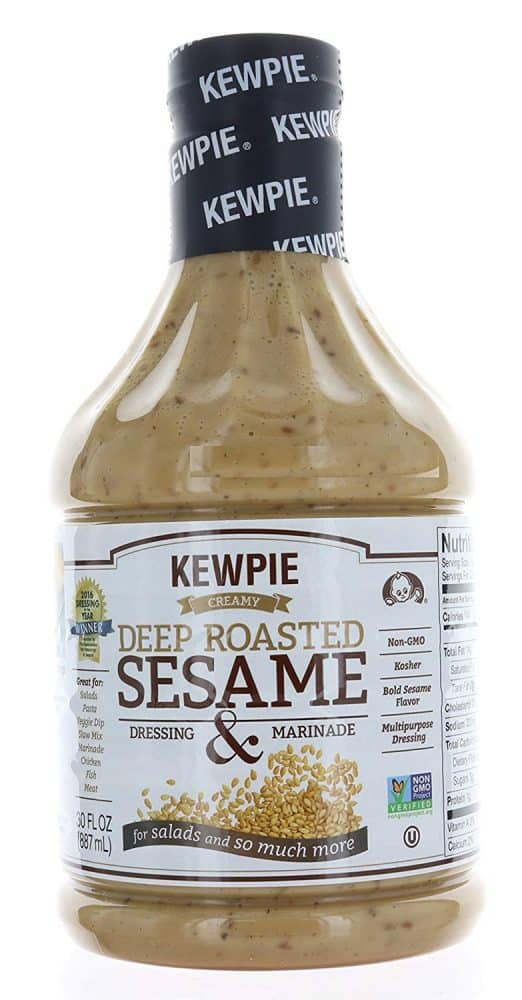
This tasty sauce is:
- non-GMO
- Kosher
- 1 tbsp = 70 calories
This is one of those high-calorie sauces you should consume in moderation.
Can’t get enough of ginger? Also try this Miso Ginger Dressing for Salad: Simple Recipe, Tasty Greens
Fish sauce
Fishy sauce with fishy sushi? Sounds perfect for seafood lovers. If you like Thai fish sauce, you need to try drizzling it on sushi and sashimi or even using it as a dipping sauce.
Fish sauce is a common Thai seasoning but also used in Japanese cuisine. The flavor is fishy of course but also earthy, savory, and a bit pungent, and slightly like mushrooms.
Best fish sauce: Thai Kitchen Premium Fish Sauce
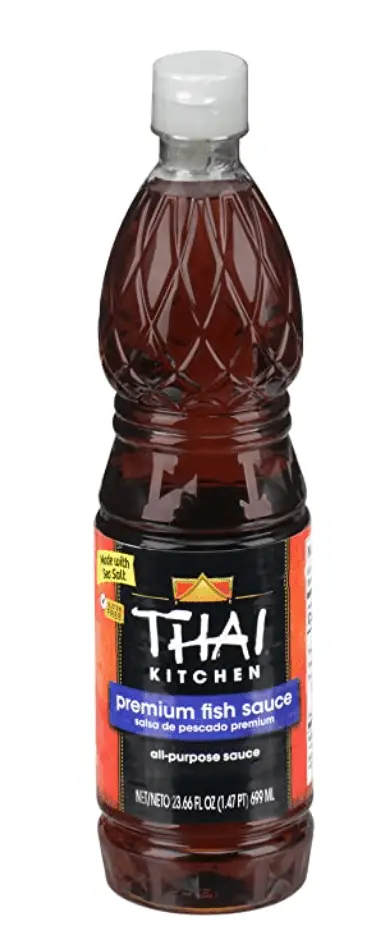
Thai Kitchen’s fish sauce is a top seller because it has a true Thai flavor and is made from salted anchovies.
- gluten-free
- dairy-free
- 1 tbsp = 10 calories
This is a great low-calorie sauce for your next sushi lunch.
Vegan sushi sauce: liquid coconut aminos
If you’re vegan, you probably want a black sauce similar to soy sauce for your sushi.
Liquid coconut aminos is a dark seasoning with a salty and savory taste. It’s made of fermented coconut palm sap mixed with sea salt. It forms a liquid, similar to a liquid sugar and it can be added to all kinds of foods.
Although it appears sugary, the flavor is salty. Coconut aminos are often used as a substitute for soy sauce in the West.
For a salty and savory sauce similar to soy sauce, try vegan sushi sauce: Bragg Coconut Aminos
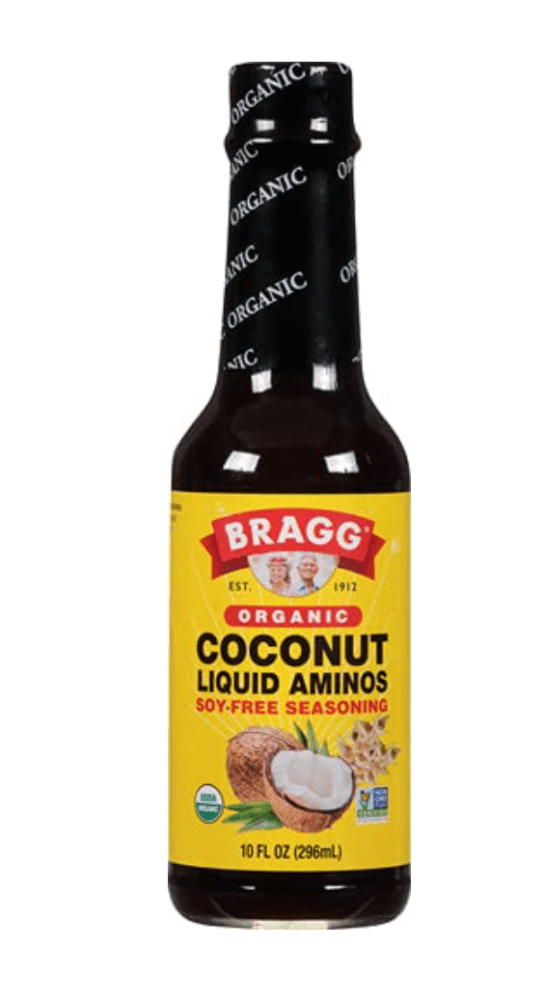
The Bragg sauce is vegan-friendly and great for people who have a soy allergy or intolerance.
- vegan
- soy-free
- organic
- 1 tbsp = 10 calories
Thus, you can use this seasoning as a sushi dipping sauce, or an alternative to Worcestershire sauce and tamari sauce if you want soy-free, vegan options.
Sweet & fruity mango sauce
Mango sauce is not the same as mango salsa; instead, it is a fine, semi-viscous sauce with a yellow color. It’s not a traditional Japanese sauce, but it tastes amazing with rice dishes or drizzled on top of fried foods.
Here’s my favorite mango sauce: Saucy Lips Tangy Mango Sauce
If you love Caribbean-style flavors, you’ll love putting some Tangy Mango sauce on your sushi.
It has a delightful sweet, fruity, and tangy mango flavor which pairs well with all kinds of rolls, but especially California rolls or dragon rolls.
Crabmeat or surimi taste great when combined with a sweeter fruity sauce.

- vegan
- keto
- gluten-free
- low calorie
- 1 tbsp = 5 calories
This mango sauce is one of the healthiest and best low-calorie sauces for sushi. With only 5 calories per tbsp, this sweet mango sauce is a healthier and keto-friendly sauce.
I recommend it for vegan sushi rolls like a cucumber or avocado roll.
Soy-free sushi sauce
This is the ultimate soy-free brown sushi sauce for those who love the umami flavors of regular soy sauce but don’t want to ingest all that sodium.
The Ocean’s Halo sauce contains 40% less sodium than regular soy sauce and it has a similar salty and savory flavor.
The best soy-free sauce: Ocean’s Halo Organic Less Sodium No Soy Sauce
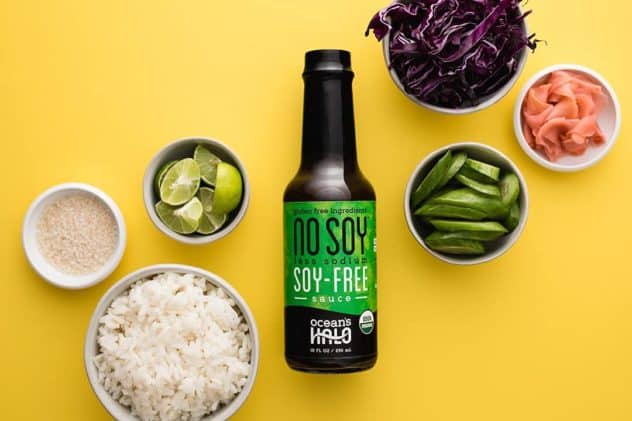
- gluten-free
- low-sodium
- no-soy
- vegan
- 1 tbsp = 5 calories
This is an excellent imitation soy sauce with no actual soy. Since it’s vegan, gluten-free, and low-calories, this is one of the healthiest sauces for sushi on my list.
Combine it with these 7 different vegan sushi roll ideas you can make at home.
Everybody’s favorite black sushi sauce
In case you’re not familiar with Japanese food, then we would like to extend our courtesy to you and tell you that we completely understand where you’re coming from.
Especially if you have little-to-no idea what that flavorful black sauce served with sushi is.
This black sushi sauce is crucial to making sushi taste delicious. Without it, sushi wouldn’t be nearly as satisfying.
Japanese cuisine offers more variations of this black sushi sauce than any other food culture in the world.
What is that black sushi sauce?
So, what is the iconic black sauce on sushi? Unfortunately, the black sushi sauce is within the gray area of the Japanese culinary arts (no pun intended), and there’s no way to tell which is which at first glance.
But you can guess which one it is when it is used to top sushi dishes. For instance, if it is drizzled on top of the sushi and has a sweet-savory flavor, it might be teriyaki sauce.
Teriyaki sauce is typically the chef’s favorite sauce for most dishes, including dragon roll, caterpillar roll, tempura shrimp roll, unagi, and many others.
If the sauce has a thicker texture that’s almost similar to syrup, then it’s likely eel sauce (nitsume).
Sometimes the chef may also use tonkatsu sauce to drizzle those modern fusion sushi delicacies. Tonkatsu sauce has a tangy taste, while teriyaki sauce is traditionally the sweeter variation of sushi sauces.
In other cases, the light black sauce used on sushi could be chirizu sauce, which enhances the flavor of seafood like aji, halibut, and other types of shellfish.
Ponzu sauce can also be used as an excellent alternative to sushi sauces due to its typical sweet taste, and it also has a reddish-black color!
You’d be surprised to know that these sauces that range from brown-black in color are all based on the age-old soy sauce, which varies only slightly in terms of flavor, taste, color, and texture.
If the sauce is served in a separate bowl as a dipping sauce, then there’s a high possibility that it could be plain soy sauce, tamari sauce, ponzu sauce, or chirizu sauce.
Black sauce used on sushi
The Western California-style rolls inspire the black sauce varieties you commonly see in sushi restaurants today. The traditional sushi dishes in Japan did not have so many varieties back in the 15th century.
Before modern times, the brownish-black soy sauce was only served as a dipping sauce for sushi rolls. But these days, there are at least a dozen different kinds of sushi sauces.
You can try sauces at your favorite sushi restaurants. You can also buy a variety of Sushi sauces at Asian grocery stores or online.
Do know that every sushi dish served at your table has already been glazed with the right amount of soy sauce?
The chef places the sauce on the fish part of nigiri or the toppings or fillings. This gives the sushi a balanced flavor.
Sauce flavor combinations
According to sushi etiquette, each sushi roll is has a perfect balance of flavors. The sushi chefs work hard to enhance the natural flavors of each ingredient.
Since the chef makes the food flavorful it’s not necessary to load up on too much sauce. If you’ll add any more sushi sauce, it ruins that balance, therefore, you should avoid doing this.
Some sushi chefs marinate or grill the ingredients with soy sauce to enhance flavor.
As well, recipes made with raw fish taste better with soy sauce. On the other hand, with uramaki (inside-out rolls), the traditional black sauce which comes in different variations is used for decorative purposes.
The chef may use teriyaki sauce, tamari sauce, or plain dark soy sauce to drizzle over the sushi toppings. This enhances the aesthetic features of the sushi dish more than make it taste great.
As sushi evolves with more fusion recipes and contemporary ideas, you can find chefs using their own custom or secret soy-sauce recipe to differentiate from others.
If you already know and use the traditional black, sweet, and spicy sushi sauce, you can switch it up with Japanese spicy mayo or ginger mayo sauce.
These spicy flavors complement many sushi pairings well and provide a delicious staple sauce for any sushi-eating occasion.
You may also try a carrot ginger sauce for a refreshing flavor. It gives your sushi dish a new funky color that’s quite pleasing to the eyes.
In modern sushi cooking art, you will find that chefs have become accustomed to preparing sushi with one or more complementary sauces on their sushi rolls.
The bottom line
Sushi rolls are flavorful and delicious on their own. But, a tasty sauce takes sushi to a whole new level.
You can experiment with sweeter flavors like Nikiri soy sauce, or keep it classic with a black soy-based sauce.
Either way, the flavors of these sauces add some kick to any sushi or sashimi meal. Don’t be afraid to experiment with sauces and condiments.
But, keep in mind the #1 rule of sushi etiquette – don’t douse your sushi in the sauce!
Now you have your sushi sauces ready, also get your hands on the best sushi makings kits available
Check out our new cookbook
Bitemybun's family recipes with complete meal planner and recipe guide.
Try it out for free with Kindle Unlimited:
Read for freeJoost Nusselder, the founder of Bite My Bun is a content marketer, dad and loves trying out new food with Japanese food at the heart of his passion, and together with his team he's been creating in-depth blog articles since 2016 to help loyal readers with recipes and cooking tips.

